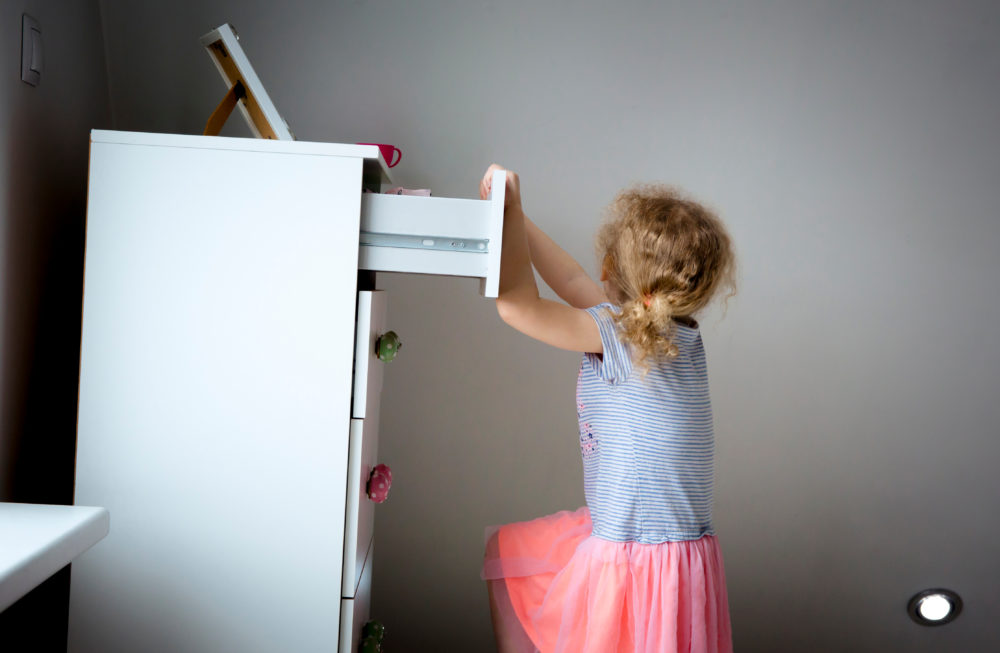CPSC Sets New Furniture Federal Furniture Standards to Prevent Child Tipover Injuries and Deaths
Nearly 500 children have died since 2000 due to furniture tip over accidents, according to CPSC records.

Following thousands of reported injuries and hundreds of child deaths caused by furniture tip-over accidents in recent years, federal safety officials have voted to pass a series of new furniture safety standards.
The U.S. Consumer Product Safety Commission (CPSC) voted three-to-one on October 19 to approve new mandatory furniture standards, which will require dressers, chests and other clothing storage units to meet new minimum stability requirements designed to prevent furniture from tipping over onto children.
Furniture tip-over prevention has been a major focus of the CPSC in recent years, following a number of incidents where children suffocated or suffered blunt force trauma injuries. These accidents often occur when a child wants to reach for something up high on a dresser or the top of a television, and their weight causes the furniture to fall on top of them.
On average, a child is sent to the emergency room for a tip-over injury every 24 minutes in America, according to the CPSC. However, these accidents are preventable if furniture is anchored to the wall.

Did You Know?
Change Healthcare Data Breach Impacts Millions of Customers
A massive Change Healthcare data breach exposed the names, social security numbers, medical and personal information of potentially 100 million Americans, which have now been released on the dark web. Lawsuits are being pursued to obtain financial compensation.
Learn MoreAccording to the new rules, clothing storage units will be required to exceed previous minimum stability requirements and display important safety information and performance and technical data. The furniture will be required to meet stability ratings based on real-world factors which often cause tipover injuries, such as weight applied to open drawers, stability on carpet and weight variations throughout different drawers.
The agency will also require furniture manufacturers to include interlock features in testing methods, which have been shown to improve the safety of furniture by only allowing one drawer to be opened at a time.
“Each year, children are killed or injured in dresser tipover incidents,” CPSC Chairman Alex Hoehn-Saric said. “The standard set today will ensure that dressers are safer and fewer children are at risk.”
Now that the furniture safety standards have passed the Commission’s vote, effective October 19, the rules will go into effect 180 days after being published in the Federal Register.
Furniture TipOver Warnings
In November 2021, the CPSC issued a furniture tip-over warning, encouraging consumers to purchase anchoring kits along with televisions, dressers, bookcases and other common household furniture items that have been linked to devastating tip-over injuries, where small children are crushed or killed under the weight of the furniture.
To prevent dressers, bookcases and other similar household furniture tip-over incidents, the commission recommended these items be placed on solid surfaces and against a wall to be properly anchored. The CPSC warns unanchored dressers placed on carpet or uneven surfaces may make them prone to tipping over.
Additionally, the agency notes children are inherently more susceptible to tip-over accidents from climbing and reaching for items at the top of dressers, or television stands, whether it is for a remote, gaming equipment or toys. Officials warn parents and caregivers to never place items up high on dressers that would encourage children to climb on them.
According to a report released by the U.S. Consumer Products Safety Commission (CPSC) in February, nearly 10,000 children were treated in U.S. emergency rooms for injuries caused by furniture tip-overs between 2018 and 2020. Since the year 2000, the CPSC reports that there were at least 472 furniture tip-over accident deaths involving children 17 years old and younger; nearly 200 of those deaths were linked to furniture classified as clothing storage units; such as dressers.
Following efforts to raise awareness about these risks, recall defectively designed furniture and promote the use of anchors, the CPSC indicates there has been a 55% decrease in tip-over injuries treated in U.S. emergency rooms across all age ranges between 2011 and 2020. The decrease is largely attributed to less tip-over injuries involving heavy televisions.





0 Comments